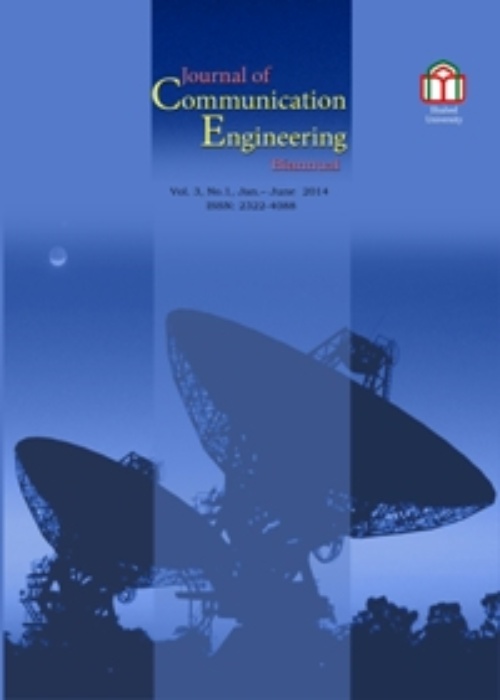فهرست مطالب

Journal of Communication Engineering
Volume:2 Issue: 2, Spring 2013
- تاریخ انتشار: 1392/05/17
- تعداد عناوین: 6
-
-
Page 73This paper proposes a two way L and S band Gysel power divider/combiner that uses line to ground resistors. Step by step methods to obtain a wide isolation and transmission bandwidth are presented. A design that uses five resistors is selected and optimized based on Quasi Newton method. Then the Defected Microstrip Structure (DMS) and Defected Ground Structure (DGS) is used to obtain better transmission and isolation in wider bandwidth. By resizing the structure to meet impedance matching, the two-way L and S band power divider is achieved. Also the optimization of the design is checked using circuit configuration. Finally, the theoretical results are validated by comparison with simulations of structure and experimental results. The simulations are found to be in good agreement with measurement results in the range of 0.7 to 4.3 GHz.Keywords: optimization, design methodology, microstrip circuit, power dividers
-
Page 89Spectrum is a valuable, scarce and finite natural resource that is needed for many different applications, so efficient use of the scarce radio spectrum is important for accommodating the rapid growth of wireless communications. Spectrum auctions are one of the best-known market-based solutions to improve the efficiency of spectrum use. However, Spectrum auctions are fundamentally different from conventional auctions because of the spectrum’s unique property of reusability. Unlike traditional goods, the spectrum can be spatially reused concurrently. To handle spectrum reusability, a buyer grouping procedure has been applied in many existing spectrum auction schemes, in which the buyer’s interference conditions are modeled as conflict graph. Buyer grouping problem can be transformed into the problem of finding chromatic number or maximum independent set of a graph, which is NP-hard and there is no efficient algorithm till now. Several approximate algorithms have been proposed to tackle the spectrum reuse problem. It is important to note that almost none of the proposed algorithms for spectrum buyer grouping have been specifically designed for spectrum allocation. However, buyer grouping in a practical spectrum auction mechanism has its own challenges. In this paper, first we illustrate the challenges of buyer grouping in a practical spectrum auction mechanism. Then we propose the novel algorithms for spectrum buyer grouping to solve these challenges. By extensive simulations, we show that our proposed algorithms can not only solve the challenges caused by radio spectrum properties but also provide good performance on various auction metrics.Keywords: Buyer Grouping, Heterogeneity, Spectrum Auction, Spectrum Reuse, Truthfulness
-
Page 107In this paper, we analyze the secure connectivity in Shotgun cellular systems (SCS: Wireless communication systems with randomly placed base stations) by Poisson intrinsically secure communication graph (IS-graph), i.e., a random graph which describes the connections that are secure over a network. For a base-station in SCS, a degree of secure connections is determined over two channel models: only path loss model and fading channels.Keywords: Local connectivity, Shotgun cellular systems, in, degree, out, degree
-
Page 121This paper concerns power allocation in relay-assisted wireless channels for two-hop transmission. First, the transmitter sends the information to both the relay and receiver parts. Next, in the second hop, the transmitter cooperates with the relay to increase the received signal to noise ratio (SNR), assuming the relay makes use of the Amplify and Forward (AF) strategy. Moreover, it is assumed a linear combiner is employed at the receiver to effectively combine the received signals of two hops. In this regard, under total transmit power constraint, an iterative power allocation strategy together with a proper combining method is proposed, showing the proposed approach achieves a comparable SNR as compared to the best known methods addressed in the literature, while having much lower complexity.Keywords: Power Allocation, relay channel, cooperative strategy
-
Page 131In this paper, we derive a capacity inner bound for a synchronous Gaussian Z channel with intersymbol interference (ISI) under input power constraints. This is done by converting the original channel model into an n-block memoryless circular Gaussian Z channel (n-CGZC) and successively decomposing the n-block memoryless channel into a series of independent parallel channels in the frequency domain using the discrete Fourier transform (DFT). The capacity inner bounds for these parallel channels can be determined easily. Since we assume that our channel is a synchronous channel, the capacity inner bound of the Gaussian Z channel with ISI is the same as the capacity inner bound of the n-CGZC in the limit of infinite block length. Moreover, some numerical results showing the loss in rate caused by ISI are given.Keywords: Capacity Region, Gaussian Channels, Intersymbol Interference (ISI), Z Channel
-
Page 143In this paper, a Peak to Average Power Ratio (PAPR) reduction technique in Orthogonal Frequency Division Multiplexing (OFDM) systems is proposed. This technique uses error correction capability of channel coding to reduce the PAPR.The coded bits at the input of OFDM modulator are separated into two groups of the Most Significant Bits (MSB) and the LeastSignificant Bits (LSB). The bits are mapped to the constellation points such that the MSBs are less affected by the channel errorthan the LSBs. In the proposed method, the MSBs are changed by an intentional error such that the PAPR is minimized. The performance of this method has been presented and it has been shown that it achieves the better performance than that of the Selected Mapping (SLM) method.Keywords: Block coding, BCH, Error Correction, OFDM, PAPR


